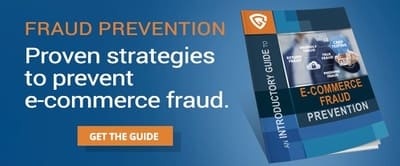Making Data-Driven Decisions With Fraud Scoring

When you look at a fraudulent transaction closely, there’s almost always some clue hidden in the data that could have alerted you to the fact that something wasn’t quite right. Screening transactions for common fraud indicators can be an effective way to protect yourself, but legitimate customers often display some of the same signs.
To avoid false positives and still maintain a high detection rate, the best approach is to employ a fraud scoring model that holistically evaluates the transaction and its fraud indicators in context. How can merchants use fraud scoring to detect and block fraudulent activity with greater accuracy?
 Fraud is rampant in the world of e-commerce, costing online retailers upwards of $20 billion per year. These losses from fraud come in the form of chargebacks, when cardholders discover they’ve been victimized and contact their banks to dispute the charges.
Fraud is rampant in the world of e-commerce, costing online retailers upwards of $20 billion per year. These losses from fraud come in the form of chargebacks, when cardholders discover they’ve been victimized and contact their banks to dispute the charges.
Unauthorized credit card transactions are considered “true fraud,” and merchants have no recourse against these chargebacks.
They can’t be fought, they can only be prevented ahead of time—making fraud prevention a top priority for every merchant that accepts payments via credit card.
There are lots of anti-fraud tools designed to help merchants with this, but all of them come with some tradeoffs. Multi-factor authentication protocols provide a nearly insurmountable obstacle for the average fraudster, but they can cause a lot of checkout friction for casual customers, leading to cart abandonment and lost sales.
Fraud filters that work behind the scenes to block suspicious transactions are less obtrusive, but getting accurate results out of them can be a challenge. One solution is to filter transactions with a fraud scoring model that can be configured and adjusted according to the individual merchant’s needs.
What Is Fraud Scoring?
Fraud scoring happens in real time, as the transaction is being processed. It involves evaluating transaction data, identifying any fraud indicators that are present, and assigning a point value to each one. The points are tallied up into a final score that determines whether the transaction should be accepted, rejected, or held for manual review.
Essentially, the score is telling you how risky it would be to accept the transaction. A very low score would represent minimal risk, while a high score would indicate a transaction that is very likely to be fraudulent.
Scores in between can be difficult to interpret, which is why it is important for merchants to be able to customize their fraud scoring models according to their own historical data.
For example, certain countries commit e-commerce fraud at higher rates and it makes sense for most merchants to assign a high point value to transactions from those countries. A retailer that specifically markets itself to customers from one of those countries, however, would generate a lot of false positives by assigning the same number of points.
How Does Fraud Scoring Actually Work?
Fraud scoring can be employed any time a customer interacts with your site—not just when they’re placing an order, but also when they’re creating accounts, logging in, or updating their customer profile. Any data associated with the interaction can be evaluated with the fraud scoring model. Here’s a list of just some of the information that can be assigned points:
- IP address
- Geolocation
- Transaction amount
- Incomplete or erroneous payment credentials
- Order history
- Shipping details
- Local time
Scoring models can go even deeper than this looking at things like the customer’s email provider (free accounts are riskier than paid ones), proxy server usage, whether or not their information was compromised in previous data breaches, and whether they have active social media accounts.
Taken in isolation, many of these factors can’t tell you anything about whether or not a customer is actually a fraudster, but when all available factors are evaluated as a whole and weighted appropriately, a clearer and more accurate picture should emerge.
Why Should Merchants Use Fraud Scoring?
An effective fraud scoring solution, properly configured, should be able to produce accurate and reliable results most of the time—rejecting orders that appear clearly fraudulent, accepting safe ones, and sending ambiguous cases for manual review. Over time, you should be able to adjust your fraud scoring parameters to improve accuracy, reducing the number of transactions you need to manually review.
 This is important for scaling up your operations. If you’re processing hundreds or thousands of transactions per day, you’ll want every single one of them to be checked for signs of fraud, but you won’t have time to review a large percentage of them.
This is important for scaling up your operations. If you’re processing hundreds or thousands of transactions per day, you’ll want every single one of them to be checked for signs of fraud, but you won’t have time to review a large percentage of them.
Fraud scoring ensures that every transaction gets evaluated while giving you the power to determine how much risk you’re willing to accept and how much time you want to spend looking over them with human eyes.
What Are the Limitations of Fraud Scoring?
No two merchants are exactly the same, and neither are any two fraud scoring models. Fraud scoring is at its most effective when you can configure it based on historical data that relates to your unique business situation. As we mentioned above, what’s highly suspicious to one merchant could be business as usual to another.
To get the most out of a fraud scoring solution, you need to analyze your transaction and customer data on an ongoing basis and make frequent adjustments to make sure that you’re giving the proper weight to every individual risk factor.
It’s also worth remembering that while fraud scoring can be very helpful in preventing true fraud chargebacks, it’s not going to do anything to stop friendly fraud. When the transaction is valid but the dispute claims are fraudulent, you have to fight the chargeback by gathering evidence that refutes the claims and submitting it with your chargeback representment. Fraud scoring can be an important element of your chargeback prevention strategy, but it’s not the answer to everything.
Conclusion
Merchants need all the help they can get when it comes to fighting e-commerce fraud, and fraud scoring tools can offer a powerful solution to the ever-present problem of true fraud.
If you need help selecting and setting up the right tools for your business, or if you’re trying to supplement your anti-fraud tools with defenses against other types of chargebacks, remember that chargeback experts are always standing by and ready to lend assistance.
Thanks for following the Chargeback Gurus blog. Feel free to submit topic suggestions, questions, or requests for advice to: win@chargebackgurus.com



